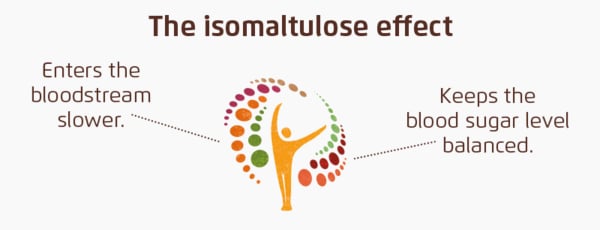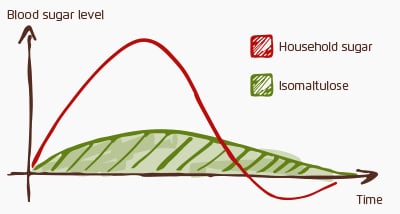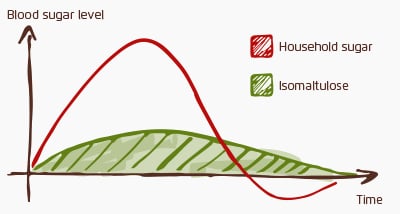
Trust your taste buds!
Experience the isomaltulose effect!
Natural harmony through a balanced metabolism
Carbohydrate cravings - never say never
GEFRO Balance is optimised for the metabolic process
What is GEFRO Balance?
Enjoy a balanced and light feeling, more concentration and energy.
Balanced insulin levels are a decisive factor for the healthy metabolism of carbohydrates. At GEFRO, we developed the Balance range specifically focusing on the body’s needs – modern, naturally tasty food with metabolically optimised recipes for a balanced blood sugar level, more concentration and energy. Because we believe good food is not only healthy but should taste good too!
Experience the isomaltulose effect!

GEFRO Balance strictly forgoes the use of crystal sugar (so called sucrose), flour and starch. Isomaltulose, which we use instead of crystal sugar, enters the bloodstream noticeably slower than sugar. That means that the blood sugar level rises less harshly and falls less severely after consuming GEFRO Balance products than it would after consuming normal sugary foods. Thus, the metabolism runs noticeably more balanced. The body can use the available energy for longer, concentration improves and the typical fatigue signs of the “lunchtime lull” disappear. By the way: the effect of isomaltulose has been tested and approved by the European Food Safety Authority (EFSA)!

Ideal for all who want to stay naturally in balance: at home, on-the-go, in school, college or at work. Sensible eating has never been so easy – or delicious!
In addition to the isomaltulose effect, you enjoy GEFRO Balance quality:
- with particularly valuable fibre
- without flavour-enhancing additives
- without colours or preservatives
- vegan**
- gluten free*
- lactose free**
** except “Fine White Sauce” and Soup-er Snack “Mushroom Mania”: with milk products
Natural harmony through a balanced metabolism
Low fat is ‘out’!
Diets low in carbohydrates are all the rage today. Instead of wholegrain bread with jam and a little raw veg, breakfast now consists of omelettes with ricotta or scrambled eggs with bacon.
These new diets are similar in that, depending on the effect on blood sugar, they either divide carbohydrates into favourable (complex) or unfavourable (quickly digestible) carbohydrates. The goal of the recommended diet is to have as little an effect on blood sugar as possible.
In recent times, the GEFRO team worked extremely hard and put a lot of thought into the topic of ‘keeping metabolism in balance’. Now, dear readers, I would like explain the role of insulin in our metabolism to you before providing more information about the new product line – GEFRO balance.
Insulin – a key hormone
Insulin, a pancreatic hormone for metabolism, provides body cells with carbohydrates, protein and fat, while the blood sugar level drops back down to its initial value. Without insulin, we would go hungry, since insulin acts as a key to open the door to the body's cells.
Each cell has a receptor, in other words, a keyhole in which the insulin ‘key’ must fit. Through obesity, too much stomach fat and a poor diet, the cell’s receptors can become damaged, so that the insulin no longer fits in the keyhole. The cells lock their front doors. Experts like to refer to this as ‘insulin resistance’. The body's cells no longer respond properly to the existent insulin. The absorption of carbohydrates becomes congested, and the pancreas tries to compensate for this by producing more insulin. High levels of insulin facilitate entry of glucose even further into the muscle cells. Anything else that can no longer be absorbed is then dumped into fatty tissue together with dietary fat. Insulin causes the build-up of fatty tissue and weight to constantly increase.
When the pancreas can no longer compensate for insulin resistance, it ultimately results in the development of diabetes.
Fats and protein in the diet have almost no effect on the release of insulin. The rise in blood sugar levels and thus the release of insulin is always a reaction to the amount and type of carbohydrates ingested.
Carbohydrates are found almost exclusively in plant foods. There is a difference between short-chain and long-chain carbohydrates. Here, single units of sugar are strung together like pearls on a string. The digestive system must break down this ‘chain of pearls’, so that the individual sugar components can be absorbed in the blood.
If we chew on a piece of bread for long, it becomes increasingly sweeter. Even while chewing, enzymes existing in our saliva already start to break down carbohydrates into their individual components. At the same time, the pancreas is working at full speed to release enough insulin.
Highly processed carbohydrates (sugar, white flour products) provoke the heavy release of insulin in order to quickly remove sugar from the blood. When this occurs, the pancreas usually overshoots the mark and releases too much insulin. As a result, shortly after the rush of sugar, the blood’s sugar level is suddenly too low. That is why we often feel so weak, tired and sluggish after eating dessert, ice cream or cake. It is then important not to continue eating sweets, otherwise the process starts all over again.
Those who understand the effect of insulin on metabolism can probably already guess what consequences this knowledge has on our daily diet. Current diets that are rich in carbohydrates force the pancreas into increasing the production of insulin. On top of all this, most people like to have snacks: a piece of bread here, a cookie there, a bowl of jelly beans on the desk, as well as an apple in the afternoon or a glass of juice – the pancreas continuously works at full speed. As already described earlier, insulin opens our cells for the absorption of nutrients, i.e. insulin ultimately promotes the build-up of fatty tissue.
As long as we have insulin circulating in our bloodstream, we are not able to break down fat; insulin keeps the cell doors open for it to build up.
The important thing is to eat on a regular basis. Skipping meals only causes uncontrollable hunger pangs to occur and you then eat more than intended.
Long breaks should be taken between meals. It is best to eat fruit with your meals, as opposed to snacking between meals. Avoiding snacking causes a reduction in blood sugar and insulin levels. Only then can fat be actively burned. The body needs approximately three to four hours until it has digested a meal and the insulin level has really dropped. In the hours thereafter, it lives from reserves. This means that the body only has a chance to break down fat deposits if we do not eat anything for more than three to four hours between meals.
Carbohydrates cravings – never say never
From personal experience, we have come to learn that cravings for carbohydrates are inevitable. Delicious pasta dishes, crispy chips, pizza and sweets appear in one’s mind over and over, and it becomes increasingly difficult to resist the temptation.
We force ourselves to eat healthy, but secretly dream of fish and chips.
Even if you opt for a low-carbohydrate diet, avoid complete bans. Resolutions, such as “starting tomorrow I won’t eat any chocolate” or “from now on I will only eat whole-grain rolls”, are doomed to fail. Thoughts permanently revolve around forbidden foods and we eventually become weak. And that is when the attitude quickly arises ‘I don’t care anymore!’ If you want to be successful, you should remain flexible in your goals.
Feeling bad about the piece of cake you enjoyed on your last birthday is not what it is about.
Whoever watches what they eat during five days of the week can indulge at the weekend with a clear conscience and enjoy their favourite foods without any worries.
Of course, it is difficult to break old habits. The process requires a lot of nerve and discipline, but it’s worth it. With time, your eating habits change completely: you tune into the signals your body gives you and consciously eat exactly what tastes good to you and what the body needs, not too much not too little. Restrictions or counting calories are no longer issues.
GEFRO Balance is optimised for the metabolic process
Be it the sauces, soups or salad seasonings, no conventional sugar has been added to the products of the GEFRO Balance product line. When asked why GEFRO puts sugar into its organic and conventional products, we usually respond as follows:
sugar enhances the flavour. If we reduce the sugar content, the taste experience of the seasonings is no longer the same as with our current recipes.
This also applies for the new products. A pinch of sugar added to the salad seasoning or to the tomato sauce rounds off the flavour and we don’t want to do without this flavour in future recipes either. However, we use another type of sugar in the Balance products – isomaltulose.
A detailed description of this sugar can be found in the last paragraph of this page, dear readers.
Unlike granulated white sugar, the individual components (glucose and fructose) found in isomaltulose are more strongly interlinked. Thanks to this special type of bond, the body can only slowly break down isomaltulose. The blood sugar levels and therefore the insulin levels rise only very slowly. In other words, blood sugar spikes do not occur as they do after eating normal sugar. The rush of energy provided by normal sugar quickly dissipates, resulting in a tired and sluggish feeling with a lack of concentration after eating a meal rich in carbohydrates. At the same, the craving for more carbohydrates increasingly intensifies.
Due to the very slow rise in the level of glucose when isomaltulose is ingested, energy is available to the body over a longer period of time, which plays a vital role not only on physical but also on mental performance. Our brains consume approximately 20% of the total energy that we ingest daily. And since the brain cannot store energy (glucose) like muscles can, it is dependent on a stable blood sugar level. If the blood sugar falls severely after heavy peaks, concentration and performance dissipate, and you fall into the so-called ‘lunchtime lull’. Who isn’t familiar with that? You just want to rest your head on the table and take a little nap.
If you have to stay fit and alert for the next meeting after lunch, what could be better than a rich and tasty soup from the new GEFRO Balance product line? The soups fill you, they are rich in healthy vegetables and provide the body with the energy it needs through slow carbohydrates. By the way, for information to flow well between the cells and synapses, a sufficient intake of fluid is particularly important. A person needs two to three litres of water a day so that oxygen can be transported easily and a sufficient supply is guaranteed for the brain.
Rich in fibre
For good soups as well as rich sauces, one thing applies: the consistency must be just right. Neither too runny nor to thick or gooey. For thickening, a little flour or some potato flour or cornstarch is usually used. These thickeners, however, add too many carbohydrates and thus contradict the demands of a metabolically optimised meal.
The GEFRO team decided to use two special ingredients: glucomannan and inulin. Detailed descriptions of both ingredients can also be found at the end of the page. Both inulin and glucomannan are starches from the plant kingdom, which are composed of long chains of sugar molecules. They have a strong ability to bind water, thus they slightly thicken the new soups and sauces. Both starches are water-soluble dietary fibres.
Dietary fibres cannot be broken down by the human digestive system. In other words, they are largely indigestible. And yet they are not simply worthless bulk – rather, they are necessary for a healthy, balanced diet. A high-fibre diet promotes healthy bowel activity and reduces the risk for cardiovascular disease and colon cancer.
Unlike traditional starches, glucomanann and inulin are not broken down in the small intestine. So eating these dietary fibres, does not cause an increase in the blood sugar level or the insulin level. The starches make their way into the lower sections of the intestine undigested and are a source of nourishment for the natural intestinal bifidobacteria. The growth of less desirable bacteria and yeasts are thereby hampered.
There is, however, one small side effect: excessive consumption of dietary fibre can stimulate bowel movements more than desired, which may result in bloating and diarrhoea.
When switching over to inulin- or glucomannan-based foods, you should initially experiment with the size of portions and let your intestine get used to the new dietary fibre.
Healthy, delicious and quickly prepared
Can the new GEFRO Soup-er Snacks be counted as classical fast food?
Fast food stands for food that is quick to prepare and can be eaten while standing and walking. Fast food is usually too fatty, salty or sweet. Many snacks do not contain enough dietary fibre, vitamins and minerals, and only make you feel full temporarily. How often do we briefly satisfy our hunger, while shopping or walking down the street? The result is that we eat too fast and the sensual pleasure of eating often falls by the wayside. Fast food is often not even perceived to be a real meal.
Based on preparation alone, the new GEFRO Soup-er Snacks certainly belong in the category of fast food.
The delicious soups are available in sachets and are ready to serve in just a few minutes. All you need to do is boil some water, pour it in, mix and enjoy. Unlike the well-known fast food dishes, GEFRO Balance products are neither too fatty nor too sweet nor low in fibre. They are optimised for the metabolic process and fulfil the criteria for a well-balanced meal.
Finally, one point that is very important to me personally: enjoying a meal doesn’t have to fall short. Whether at the office, on campus or at home. Make eating the GEFRO soup-er snacks an everyday treat. Use a pretty place mat, your favourite soup bowl, a spoon or a beautiful napkin, and then all you need to do is to take a break and enjoy. Afterwards, you can take on the day once again with renewed energy.
Beneficial ingredients
Inulin
Inulin is a type of starch that is widespread in the plant kingdom. Jerusalem artichoke (also known as sunchoke or earth apple), chicory, artichokes, asparagus and black salsifies are rich in inulin. Starch is made up of a long chain of sugar molecules, which can consist of up to 100 individual components. Inulin is a so-called polysaccharide. For food manufacturing, inulin is mainly derived from chicory root. Chicory is known to many as a tasty type of lettuce.
Although the spelling only differs by one letter, inulin should not be confused with insulin. While insulin has a direct effect on the blood sugar level, the consumption of inulin has no effect on it.
In terms of nutrition, sweet-tasting inulin belongs to the prebiotic, water-soluble dietary fibres. Prebiotic dietary fibres are consumed with food but cannot be broken down in the human body’s small intestine. The prebiotics make their way undigested into the lower sections of the intestine and are a source of nourishment for the natural intestinal bifidobacteria. The growth of less desirable bacteria and yeasts are thereby hampered. When metabolising inulin, short chain fatty acids and lactic acid are formed that lower the pH in the colon. Through this slight shift in pH, the solubility of calcium is also increased and improved absorption via the colonic mucosa is promoted. Through a swelling effect, the stool volume of the intestine is increased and the feeling of satiety sets in quicker. The metabolism of inulin has a positive effect on intestinal flora’s composition, and healthy intestinal flora strengthens the immune system and promotes digestion.
In addition to inulin’s many positive qualities, there is, however, one small side effect: excessive consumption of this dietary fibre can stimulate bowel movements more than desired. It may result in bloating and diarrhoea. The recommended intake for adults is 5 g daily.
In the food industry, inulin is used for its properties in spreads, baked goods, dairy products and salad dressings. Thanks to its high swelling ability, inulin bonds with water and can be used as a thickening agent. The slightly sweet flavour helps to reduce the need for other sweeteners. The taste of inulin is creamy and smooth and is therefore often used in low-fat dairy products. Inulin only has 2 cal per gram.
Glucomannan (konjac flour)
Glucomannan, also referred to as konjac mannan, is a water-soluble dietary fibre, which is derived from devil’s tongue, better known as konjac root. The konjac plant is found mainly in East Asia. Konjac flour has been used in Asian cooking since around the 1500s, for making glass noodles, for example. Glucomann is used for thickening, jellifying and as a bulking agent in the production of food.
Like inulin, glucomannan is a type of starch, which is composed of a branched chain of sugar molecules that is referred to as a polysaccharide.
Glucomannan is a dietary fibre and possesses a particularly high swelling capacity. In literature, this natural product is described as having the highest known water-binding capacity. It can bind 50 times the amount of water of its own weight. For this reason, konjac flour is also increasingly being used for saturation in dietetic products. Thanks to glucomannan’s high swelling ability, gastric emptying is slowed down and satiety sets in. Due to this swelling ability however, it is extremely important to drink enough water so that no blockages occur in the oesophagus or stomach.
Just as with the consumption of inulin, insulin and blood sugar levels do not increase when glucomannan is consumed. Intensive research is currently being carried out on the usefulness of glucomannan in dealing with metabolic disorders, such as diabetes and obesity. Positive results have already been reported here.
The metabolism of glucomann is the same as with inulin. The starches make their way into the lower sections of the intestine undigested and are a source of nourishment for the natural intestinal bifidobacteria. The growth of less desirable bacteria and yeasts are thereby hampered. There is, however, a small side effect: excessive consumption of dietary fibre can stimulate bowel movements more than desired. It may result in bloating and diarrhoea.
When switching over to inulin- or glucomannan-based foods, you should initially experiment with the size of portions and let your intestine get used to the new dietary fibre.
Isomaltulose
Isomaltulose is a natural product and is extracted from beet sugar through an enzymatic process. Isomaltulose is naturally present in honey and sugar cane juice. As a carbohydrate, isomaltulose belongs to the group of disaccharides. As with granulated white sugar, the individual components are glucose and fructose.
Although isomaltulose and sucrose have the same caloric value of 4 kcal per gram, using isomaltulose as a sweetener has distinct advantages:
the individual components in isomaltulose have stronger bonds than in sucrose. Thanks to this special type of bond, the body can only slowly break down isomaltulose. The blood sugar levels and therefore the insulin levels only rise very slowly. In other words, blood sugar spikes do not occur as they do after eating normal sugar. The very slow rise in levels of glucose means that energy is available to the body over a longer period of time, which plays a vital role not only on physical but also on mental performance.
The figure below shows the different progression of blood sugar levels after eating normal granulated white sugar (depicted red in the diagram) and isomaltulose (depicted blue in the diagram).

Isomaltulose is dental friendly and, unlike other sugar substitutes, does not work as a laxative.




